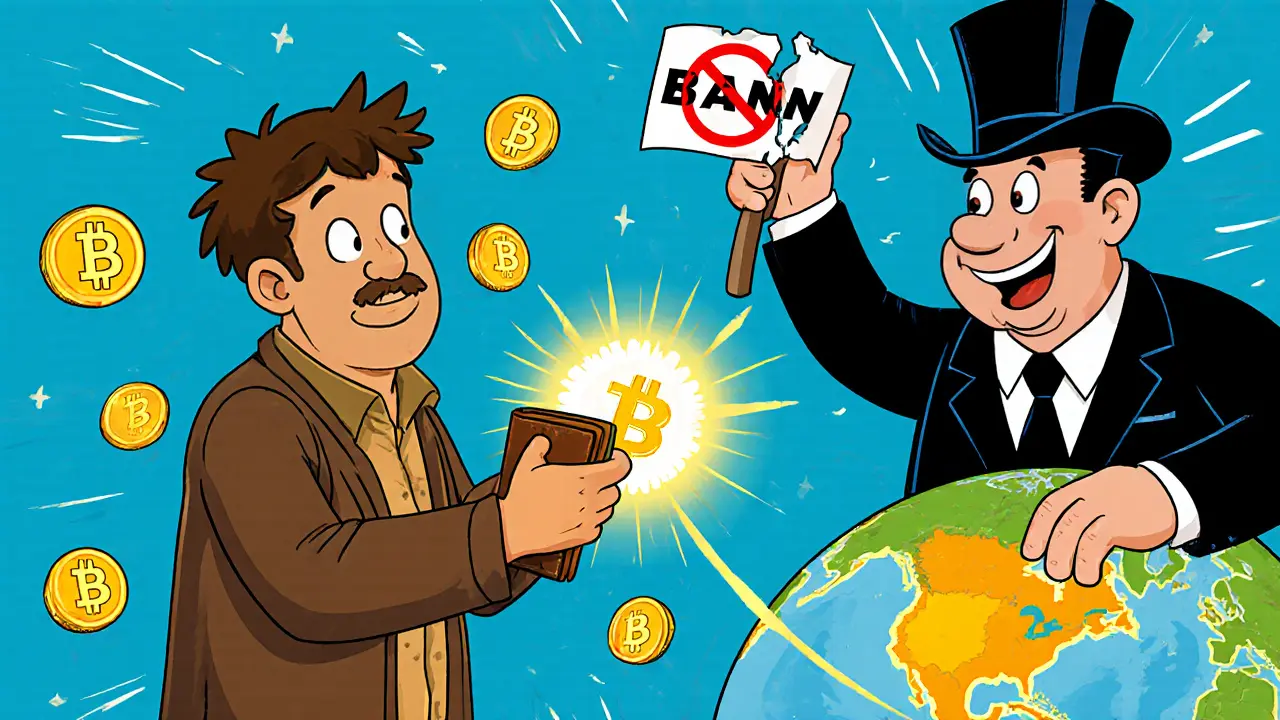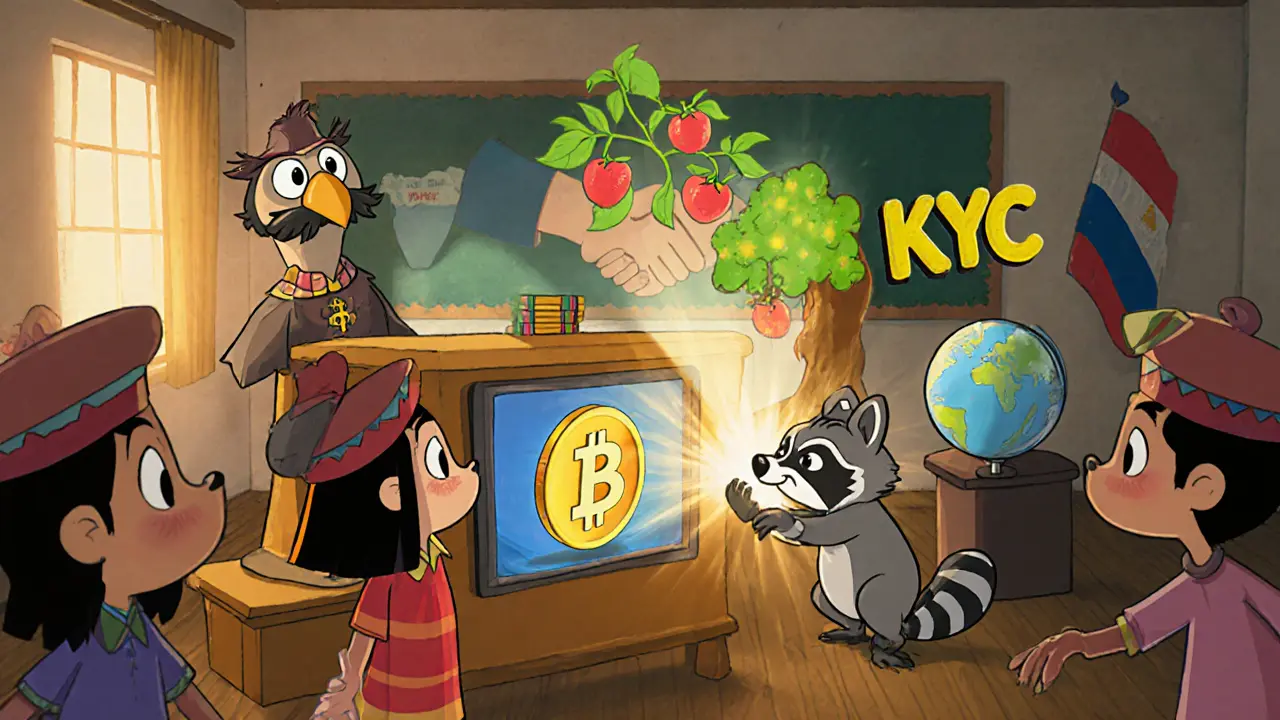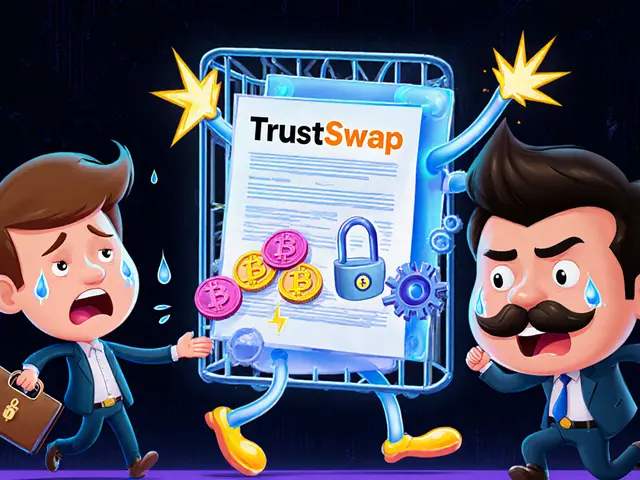
Bolivia Remittance Cost Calculator
Calculate Your Savings
Compare traditional remittance costs with cryptocurrency transfers in Bolivia. The article mentions that crypto transfers now cost under 2% versus 8-12% for traditional methods.
The data reflects Bolivia's current regulations where crypto transfers can reduce fees from 8-12% to under 2%. Note that this is an estimate based on published information.
For nearly a decade, Bolivia was one of the strictest countries in the world when it came to cryptocurrency. In 2014, the Central Bank of Bolivia (BCB) issued a total ban on all digital currencies - no trading, no mining, no wallets, no exchanges. The rule was clear: using Bitcoin, Ethereum, or any other crypto was illegal. The government said it was to protect people from fraud, money laundering, and financial instability. But behind the scenes, Bolivians were already finding ways around the ban. They used peer-to-peer networks, foreign platforms, and even cash trades to buy and sell crypto. The law existed on paper, but in practice, demand never died.
The Ban That Didn’t Stick
The 2014 prohibition wasn’t just a policy - it was a reflection of Bolivia’s deep distrust of unregulated financial systems. The country had seen hyperinflation, currency devaluations, and banking crises. The Central Bank wanted to keep control. But as global crypto adoption exploded, Bolivians kept using digital assets anyway. Remittances from abroad, which make up a big part of Bolivia’s economy, became harder and more expensive without crypto. People in rural areas, far from banks, turned to Bitcoin to send money home. A farmer in Cochabamba could receive dollars via a crypto wallet from a relative in Spain - faster and cheaper than any traditional wire transfer. By 2020, the ban was still in place, but enforcement was patchy. The government had no real tools to track crypto transactions. Most users operated through offshore platforms, making it nearly impossible to prosecute anyone. The ban became more symbolic than effective. And then, in 2024, everything changed.The Flip: From Ban to Legal Framework
On June 26, 2024, the Central Bank of Bolivia quietly reversed course. Resolution No. 82/2024 lifted the cryptocurrency ban. It wasn’t a sudden decision. Behind closed doors, officials had been studying how other countries handled digital assets - especially El Salvador, which made Bitcoin legal tender in 2021. But Bolivia didn’t copy that model. Instead, it chose a slower, more controlled path. By March 2025, the BCB started using USD-pegged stablecoins for government-backed cross-border payments. That’s a huge shift. A central bank using crypto isn’t just accepting it - it’s integrating it into its core operations. Then came Resolution No. 019/2025 in April, which officially recognized virtual assets and the companies that serve them. By May, Supreme Decree No. 5384 gave the full legal framework: crypto exchanges, wallet providers, and trading platforms now need licenses to operate in Bolivia. This wasn’t just about letting people trade Bitcoin. It was about bringing the underground market into the light. Now, if you run a crypto exchange in La Paz, you have to register with the government, follow anti-money laundering rules, and keep records. That means more safety - and more accountability.
Adoption Skyrockets After the Ban Lifted
The numbers tell the real story. In the first six months of 2025, Bolivians completed $294 million in virtual asset transactions. That’s more than the entire country’s crypto volume in the previous decade combined. One local wallet platform, Meru, saw its user base grow by 6,600% in under a year. People aren’t just experimenting - they’re relying on crypto daily. Why now? Because the need was always there. Bolivia’s local currency, the boliviano, has lost value over time. Inflation hit 5.8% in 2024, and many people lost trust in banks. Stablecoins - digital tokens tied to the U.S. dollar - became a lifeline. A mother in Santa Cruz could save money in USDT without worrying about her savings shrinking. A small business owner could pay suppliers in Colombia without waiting days for a bank transfer. Bitcoin, meanwhile, became the go-to for international remittances. With over 1.5 million Bolivians living abroad, mostly in Spain and the U.S., sending money home used to cost 8-12% in fees. Now, with crypto, it’s under 2%. That’s thousands of dollars saved every year by families who rely on those payments.How Bolivia’s Approach Is Different
Bolivia didn’t go all-in on Bitcoin like El Salvador. It didn’t make crypto legal tender. Instead, it built a regulatory sandbox. The government didn’t pick winners - it created rules for everyone. That’s why you now see a mix of users: some trade Bitcoin for long-term value, others use stablecoins for daily transactions, and a growing number use DeFi platforms to earn interest on their holdings. This pragmatic approach is what sets Bolivia apart. In neighboring Argentina, crypto is popular but chaotic - no clear rules, lots of scams. In Chile, it’s well-regulated but slow-moving. Bolivia moved fast but carefully. It didn’t just open the door - it installed locks, cameras, and security guards. The partnership with El Salvador is key. In 2025, Bolivia signed a Memorandum of Understanding with El Salvador’s National Commission for Digital Assets. They’re sharing tools to track illegal crypto use, training regulators in blockchain analytics, and building joint risk models. This kind of international cooperation is rare in Latin America. It shows Bolivia isn’t just reacting - it’s planning for the future.
What Users Are Saying
On social media and local forums, the reaction has been overwhelmingly positive. “I finally feel like I can save money without losing half of it to inflation,” said Maria Lopez, a teacher in Cochabamba who now holds USDC in a local wallet. “I used to have to carry cash to the bank just to send money to my sister in Miami. Now I do it in 10 minutes.” But not everyone is thrilled. Some worry the government is moving too fast. “They legalized crypto, but where are the consumer protections?” asked Luis Vargas, a financial advisor in La Paz. “What happens if a platform crashes? Who gets your money back? There’s still no deposit insurance for crypto.” The Central Bank is aware. Public awareness campaigns have started - free workshops in schools, community centers, and even churches. Videos in Quechua and Aymara explain how wallets work. The message: crypto isn’t magic. It’s a tool. And like any tool, it can be used well or badly.What’s Next for Bolivia’s Crypto Scene
The next phase is about scaling safely. The government is working on a national digital identity system that could link to crypto wallets, making it easier to verify users and prevent fraud. Banks are starting to offer crypto custody services. International exchanges like Binance and Kraken have opened local support teams. Experts predict Bolivia will become a regional hub for regulated crypto innovation. With its stable political environment, growing tech workforce, and clear rules, it’s attracting startups from across Latin America. The goal isn’t to become the next crypto capital - it’s to give ordinary people more financial freedom, without risking the entire economy. The journey from complete prohibition to regulated adoption took 10 years. But the real story isn’t the ban. It’s what happened after it was lifted. Bolivia didn’t just change its laws - it changed how its people think about money. And that’s the most powerful shift of all.Is cryptocurrency legal in Bolivia today?
Yes, cryptocurrency is fully legal in Bolivia as of June 26, 2024, after the government lifted its decade-long ban. Virtual assets and crypto service providers are now regulated under Resolution No. 82/2024 and Supreme Decree No. 5384, which require licensing, transparency, and compliance with anti-money laundering rules.
What happened to the old crypto ban in Bolivia?
The original ban, introduced in 2014 and reinforced in 2020, made all cryptocurrency transactions illegal under Central Bank Resolution N° 144/2020. But enforcement was weak, and demand never disappeared. In 2024, the government formally repealed the ban, recognizing that prohibition had failed to stop usage - it only pushed it underground. The new laws replaced the ban with a regulated framework.
Can I use Bitcoin to pay for goods in Bolivia?
Not officially. Bitcoin is not legal tender in Bolivia, unlike in El Salvador. However, businesses can accept it voluntarily as a form of payment, as long as they report the transactions and comply with tax and anti-fraud rules. Most users prefer stablecoins like USDT or USDC because they’re tied to the U.S. dollar and avoid Bitcoin’s price swings.
Are crypto exchanges allowed to operate in Bolivia?
Yes, but only if they’re licensed by the Central Bank of Bolivia. Under Supreme Decree No. 5384, all virtual asset service providers - including exchanges, wallet providers, and trading platforms - must register, undergo audits, and follow strict KYC and AML procedures. Unlicensed platforms are considered illegal and can be shut down.
Why did Bolivia change its mind about crypto?
Bolivia realized its ban wasn’t working. People were still using crypto anyway - for remittances, savings, and cross-border trade. The Central Bank saw that blocking access hurt ordinary citizens more than it protected them. With inflation rising and banking access limited, crypto became a practical solution. The government chose to regulate instead of ban, using international partnerships and smart rules to protect users while allowing innovation.
Is Bolivia becoming a crypto hub in Latin America?
Yes, and fast. With $294 million in crypto transactions in just the first half of 2025 and a clear regulatory framework, Bolivia is emerging as a model for balanced crypto adoption. Unlike countries that banned crypto or rushed into Bitcoin as legal tender, Bolivia is building infrastructure slowly and safely. Its partnership with El Salvador and focus on stablecoins and institutional use make it a rising player in the region.





